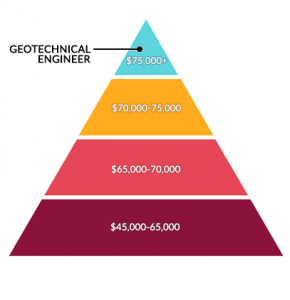Facts About Geotheta Revealed
Facts About Geotheta Revealed
Blog Article
The Greatest Guide To Geotheta
Table of ContentsThe Only Guide to GeothetaHow Geotheta can Save You Time, Stress, and Money.The Greatest Guide To GeothetaNot known Facts About GeothetaThe smart Trick of Geotheta That Nobody is Talking About

They conduct website investigations, collect examples, execute research laboratory tests, and assess data to review the suitability of the ground for construction projects - Geo Tech Engineering. Based on their searchings for, geotechnical engineers provide referrals for foundation layout, incline security, retaining structures, and reduction of geotechnical risks. They team up with various other specialists, such as engineers, architectural designers, and construction groups, to guarantee that geotechnical considerations are integrated right into the overall job style and implementation
By assessing the actions and buildings of dirt and rock, they can determine prospective geotechnical dangers such as landslides, dirt negotiation, or incline instability. Their experience helps prevent failures or crashes that might threaten lives and residential or commercial property. Right here are some detailed tasks and obligations of a geotechnical engineer: Site Investigation: Geotechnical designers conduct website examinations to collect information on subsurface problems.
They interpret the data to understand the residential properties and actions of the soil and rock, including their strength, permeability, compaction features, and groundwater conditions. Geotechnical Analysis and Layout: Geotechnical engineers examine the information collected throughout website examinations to examine the stability and suitability of the website for building tasks. They do geotechnical calculations and modeling to review factors such as birthing ability, settlement, slope stability, lateral planet pressures, and groundwater circulation.
Getting My Geotheta To Work
Foundation Style: Geotechnical engineers play a critical role in creating structures that can securely support the desired structure. They assess the dirt problems and lots needs to identify the ideal structure type, such as superficial foundations (e.g., footings), deep foundations (e.g (https://www.4shared.com/u/w_sNL5Rc/ianhammond2191.html)., stacks), or specialized methods like soil renovation. They consider factors such as settlement limitations, birthing ability, and soil-structure communication to establish ideal structure designs
They evaluate construction plans, display website activities, and perform field assessments to confirm that the design recommendations are adhered to. If unanticipated geotechnical concerns develop, they evaluate the circumstance and provide referrals for remediation or changes to the style. Danger Evaluation and Reduction: Geotechnical designers assess geotechnical hazards and threats connected with the project website, such as landslides, liquefaction, or soil disintegration.

Cooperation and Interaction: Geotechnical engineers work very closely with other specialists associated with a project, such as engineers, architectural designers, and building and construction teams. Effective interaction and collaboration are vital to incorporate geotechnical factors to consider right into the overall task design and building and construction process. Geotechnical look at here designers provide technological proficiency, response queries, and make sure that geotechnical demands are fulfilled.
4 Easy Facts About Geotheta Shown
Here are some sorts of geotechnical engineers: Foundation Designer: Structure designers focus on making and examining structures for structures. They examine the dirt conditions, tons demands, and site qualities to establish the most ideal foundation type and style, such as superficial structures, deep foundations, or specialized methods like heap foundations.
They assess the elements influencing slope security, such as dirt buildings, groundwater conditions, and incline geometry, and develop methods to stop incline failures and mitigate dangers. Earthquake Engineer: Earthquake engineers specialize in examining and designing structures to stand up to seismic pressures. They analyze the seismic hazard of a website, review dirt liquefaction capacity, and establish seismic design standards to ensure the safety and strength of structures during quakes.
They perform area testing, accumulate examples, and examine the accumulated data to characterize the dirt residential or commercial properties, geologic formations, and groundwater problems at a site. Geotechnical Instrumentation Designer: Geotechnical instrumentation designers focus on monitoring and measuring the habits of soil, rock, and structures. They set up and keep instrumentation systems that keep an eye on elements such as soil negotiation, groundwater levels, incline activities, and architectural displacements to assess efficiency and offer early cautions of prospective concerns.
A Biased View of Geotheta
They conduct examinations such as triaxial examinations, consolidation tests, straight shear tests, and permeability tests to gather information for geotechnical evaluation and layout. Geosynthetics Engineer: Geosynthetics engineers concentrate on the design and application of geosynthetic materials, such as geotextiles, geogrids, and geomembranes. They make use of these products to enhance dirt security, strengthen inclines, give water drainage services, and control disintegration.
They often tend to be investigative people, which suggests they're intellectual, introspective, and investigative. They wonder, systematic, sensible, logical, and logical. A few of them are likewise social, suggesting they're kind, charitable, participating, individual, caring, helpful, understanding, skillful, and pleasant. Does this seem like you? Take our complimentary job test to discover if geotechnical engineer is just one of your top profession suits.
In the workplace atmosphere, geotechnical designers make use of specialized software program tools to do computations, develop layouts, and analyze information. They prepare records, evaluation project specifications, communicate with clients and employee, and coordinate job tasks. The workplace setting supplies a conducive environment for research, analysis, and partnership with other professionals included in the task.
A Biased View of Geotheta
They frequently visit job websites to conduct website investigations, evaluate geotechnical problems, and gather information for evaluation. These brows through involve traveling to various locations, in some cases in remote or tough terrains. Geotechnical designers might carry out dirt sampling, conduct tests, and display construction tasks to make sure that the geotechnical facets of the task are being carried out properly.
Geotechnical designers likewise work in specialized geotechnical research laboratories. Geotechnical laboratory engineers work extensively in these atmospheres, dealing with testing devices, running tools, and taping information.
Report this page